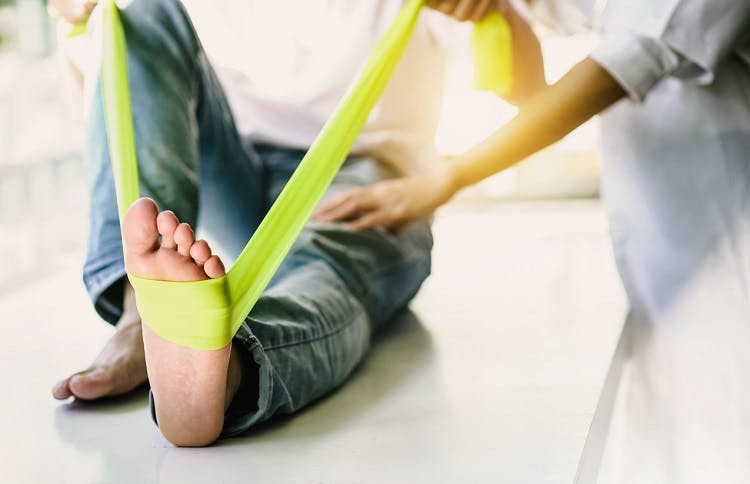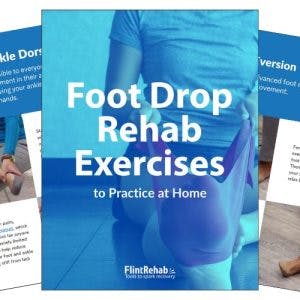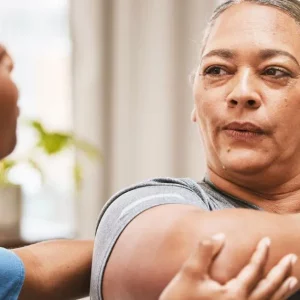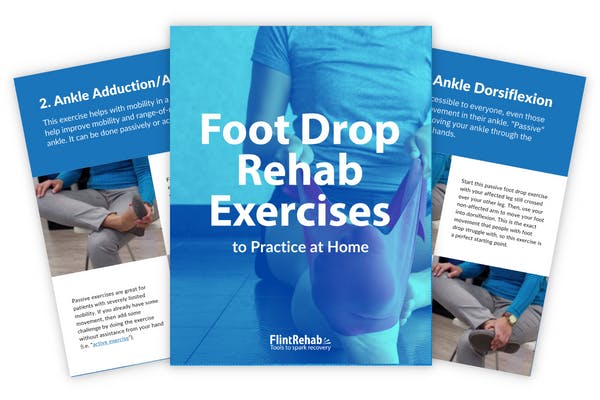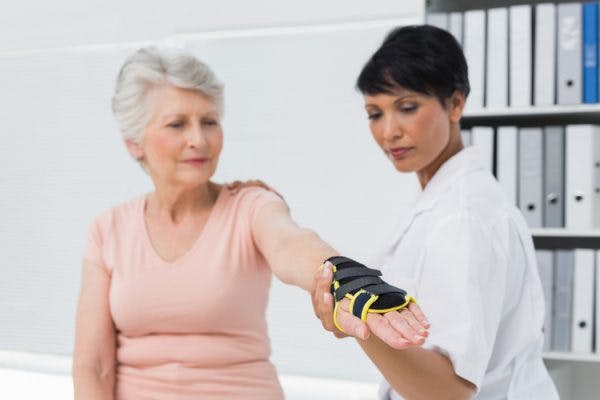The inability to lift the front portion of the foot, known as foot drop, can be caused by a variety of factors including a neurological injury like stroke or TBI. Fortunately, foot drop can be improved with a proper rehabilitation plan and a combination of other treatments.
While the recovery process can be challenging, it helps to watch for foot drop recovery signs to keep yourself motivated to continue working hard during the rehabilitation process.
This article will discuss some of the most common signs of healing foot drop as well as ways to help boost recovery.
Causes of Foot Drop
To understand the signs of healing from foot drop, it first helps to understand what causes this condition. Knowing the root cause of foot drop can help you seek the appropriate treatment in a timely manner.
Foot drop is characterized by the inability to execute a movement of the foot called dorsiflexion. Dorsiflexion involves lifting the front portion of your foot toward your shin. Without this movement, the foot may “drop” or be difficult to raise, causing your toes to drag on the floor when walking, which can increase the risk of tripping, falling, and further injury.
Foot drop can be caused by various conditions including:
- Neurological conditions: Stroke, TBI, and multiple sclerosis can cause muscle weakness or paralysis of the leg and foot muscles, resulting in foot drop.
- Peroneal nerve damage: The peroneal nerve is a branch of the sciatic nerve that supplies movement and sensation to the lower leg, foot, and toes. Damage to this nerve following a trauma, such as fracture or surgical complication, can impair dorsiflexion and lead to foot drop.
- Neuromuscular diseases: Various neuromuscular diseases such as muscular dystrophy and amyotrophic lateral sclerosis (ALS) can cause progressive muscle weakness and loss of muscle control.
- Prolonged physical activities: Squatting, kneeling, and crossing your legs habitually or for long periods of time can compress the peroneal nerve and increase the risk of developing foot drop.
Wearing a leg cast for prolonged periods of time can also exert pressure on the peroneal nerve and increase the risk of foot drop. If you are required to wear a cast, it is important to ask your doctor to evaluate your leg muscles regularly. They can also provide you with an accurate diagnosis if any foot drop symptoms are present.
Symptoms of Foot Drop
Depending on the underlying cause of foot drop, individuals may experience a variety of symptoms. Typically, foot drop causes the toes to drag on the floor when walking or performing daily activities, such as climbing stairs or a curb. You may also notice changes in your walking pattern such as high-stepping or circumduction (swinging the leg in a semi-circle) in order to avoid dragging the toes. Symptoms may be intermittent or constant and may affect one or both feet.
Additional signs and symptoms of foot drop may include:
- Weakness or decreased muscle mass
- Numbness or tingling in the leg or foot
- Worsening balance
As you work towards rehabilitation, you can identify signs of healing foot drop by monitoring these symptoms for improvement. Symptoms of foot drop may worsen over time if not treated properly, so staying motivated and continuing to work with your physical therapist is crucial.
Foot Drop Recovery After Neurological Injury
When an individual sustains a neurological injury like stroke or TBI, the communication between the brain and muscles may be disrupted. Fortunately, the brain is capable of healing and rewiring itself through a process known as neuroplasticity.
Neuroplasticity works to strengthen existing neural connections and to create new ones. As the brain strengthens its ability to send signals to the affected muscles, movements like dorsiflexion can be improved or restored. This promotes recovery from foot drop as well as improvement in overall function.
The best way to activate neuroplasticity is by practicing high repetition of foot drop exercises. The more a movement is practiced, the more the brain will recognize that movement and strengthen its neural connections. When the strength or ease of a movement improves, this can indicate a positive sign of foot drop recovery.
Your physical therapist can provide you with specific exercises that are safe and appropriate for your condition. They can also provide you with a customized exercise program you can perform at home in between therapy sessions or recommend another at-home therapy program to help you stay motivated during the recovery process.
Some individuals may also benefit from a combination of therapeutic exercises and other interventions such as an AFO brace, nerve stimulation, or surgery. It is important to consult your doctor to find the best treatment plan for you.
Foot Drop Recovery Signs
During rehabilitation for foot drop, it can be helpful to watch for signs of healing or improvement in order to stay motivated and focused on achieving your rehab goals. Staying motivated can help you continue to work hard and stay consistent with your exercises.
Some signs of foot drop recovery may include:
- Increased dorsiflexion
- Improved gait (walking pattern) and balance
- Enhanced coordination in the calf, foot, and ankle
- Decreased frequency of tripping or falling
- Increased independence with daily activities
Another indication of healing may be muscle twitching, particularly for individuals with severe foot drop after a neurological injury. As the brain rewires itself through neuroplasticity, initial signs of movement may involve muscle twitching, indicating muscle activation which is a sign of healing from foot drop.
The road to recovery is not linear, and signs of foot drop recovery depend on the unique individual, the root cause of their specific condition, and their treatment plan. With a proper rehabilitation regimen and consistent repetition of therapy exercises you can maximize your chances of seeing foot drop recovery signs more swiftly.
How Long Does It Take to Heal from Foot Drop?
Foot drop often takes time to improve, and it can be hard to notice the signs of recovery day to day. During your rehabilitation journey it may be helpful to keep track of your progress in a journal. A recovery journal can help you monitor goals, show exercise progression, and identify any signs of foot drop recovery that you might otherwise overlook.
Many individuals are eager to recover as fast as possible, and understandably so. However, it is difficult to estimate a timeline for foot drop recovery because this can vary widely and depends on the cause and severity of the condition. For example, in peripheral compressive neuropathy, recovery can occur as early as 3 months if the compression is resolved.
Another study found that individuals with degenerative lumbar disease were able to improve foot drop in 6 weeks following surgical intervention. However, these are just two studies that look at specific and uncommon causes of foot drop. Foot drop following a neurological injury such as TBI or stroke may take months or even years to improve. Each individual is unique and recovery varies widely, so it is best to focus on your independent rehab journey and avoid comparing to other cases.
The best way to estimate your recovery timeline is to talk with your doctor and therapist and establish a comprehensive treatment plan. While recovery time varies from person to person, one thing is clear: consistent rehabilitation leads to faster signs of recovery than neglecting your rehab exercises. It is vital to dedicate yourself to a consistent foot drop exercise regimen to maximize neuroplasticity and improve function during daily activities.
Understanding Foot Drop Recovery Signs
Foot drop can be caused by various conditions such as stroke or TBI. Fortunately, there is hope for recovery through a personalized rehabilitation plan. While the rehab process can be challenging and may take time, it helps to look out for signs of healing foot drop such as improved dorsiflexion, gait, and independence.
We hope this article helped you understand some of the signs of healing foot drop and encouraged you to pursue rehabilitation.

